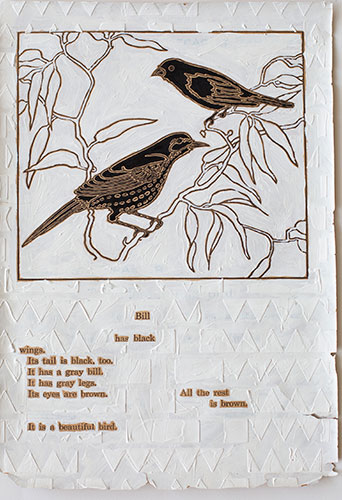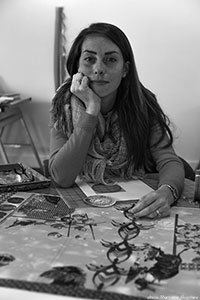Artists who have chosen careers in education shape their lives and careers through creativity, resourcefulness and adaptability. Those skills are being put to the test as faculty members in the College of Fine Arts look for ways to continue to flex their creative muscles at a time when their traditional avenues – performances, live productions and exhibits – are extremely limited.
Faculty members have been taking different paths to keep their creativity alive. Some are continuing their work, but in a virtual space; some are collaborating across disciplines’ and others are seeking out new outlets entirely.

Making a Scene
In a “normal” year, creative activity for Joe C. Klug, assistant professor of scenic design in the School of Theatre, Film and Television, would involve working as a scenic designer for a dozen or more shows with theater companies throughout the United States. This year, however, he says he has taken “the world’s worst forced vacation.”
Until live audiences can return, many theater companies are turning to digital productions. With actors performing remotely, there is little opportunity for scenery. The Hangar Theatre in Ithaca, New York, enlisted Klug to produce digital slides for its Zoom production of “The Skin of Our Teeth.” During the reading of the play on May 23, the slides illustrated elements of scenery alongside the actors to help viewers picture where the scene was taking place.
Klug – who traditionally uses small-scale physical models in his scenic design – has also spent time over the past several months teaching himself computer-aided 3D modeling and rendering programs, which he says will help him fill a gap in his curriculum. He put those new skills to the test by remotely designing the set for a summer production of “The Odd Couple” at the Oregon Cabaret Theatre in Ashland, Oregon.
In addition to the art itself, Klug says he has missed the camaraderie of theater.
“I hadn’t realized how much of my own personal human identity is built into my work. Having all of that go away and not being able to connect with people I normally connect with through my work was a shock,” Klug said. “It was nice to connect with artists in general.”
‘Reframing’ Art
Other faculty members are finding outlets for creativity through collaboration with colleagues. Autumn Eckman, assistant professor in the School of Dance, was scheduled to join a performance tour in Iceland in March. She was sent home almost immediately after arriving due to the outbreak of the pandemic. Since then, she has used her time at home to find ways to reimagine some of the pieces she had planned to perform during that tour.
“I’ve used the past several months as ‘lab time’ to teach myself new skills and to reach out to other artists to collaborate in a multimedia format,” Eckman said.
Eckman joined forces with colleagues to create dance films. “Shape-less” – a collaboration with Jonathan Marquis, who was completing his Master of Fine Arts during the spring semester, and Robert LeGendre, an accompanist with the School of Dance – is inspired by the experience of stepping back into the world after quarantine. The production was filmed at Mount Lemmon, supported in part by a grant from the Arizona Commission on the Arts.
“I literally had not left my house since March 15,” said Eckman, reflecting on how the piece spoke to her own experience as well. “The idea was to start in a place of elevation where then I had to improvise my way down. I wanted to capture this moment of physical and tactile grounding with the Earth before ascending back up again.”

“Reframe” was a collaboration involving Michelle Gott, assistant professor in the Fred Fox School of Music, and Dorsey Kaufmann, who was completing her Master of Fine Arts during the spring semester. Looking to evoke the feeling of isolation, Eckman and Kaufmann shot the film in abandoned buildings throughout Tucson. Gott recorded the film’s score on her harp in her apartment in Ottawa, Canada.
“It’s been kind of fun to use that creative muscle differently,” Eckman said. “Who would have ever thought we’d have a niche with harp, dance and digital media? But it works, and we truly, truly enjoy working together. We have all grown from this.”
To learn about another creative collaboration, read this Lo Que Pasa story about Yuanyuan “Kay” He and Daniel Linder, both assistant professors in the Fred Fox School of Music, collaborating on light painting.

Finding New Outlets
Aaron Coleman, assistant professor in the School of Art, says he is “extremely productive” in a typical year, working primarily in printmaking. He has been limiting his time in outside studios in hopes of avoiding exposure, but that has not limited his opportunities to create.
“Luckily for me, I have never pigeonholed myself into one way of making,” Coleman said. “I’m always changing, I’m always evolving, and I’m always thinking about what materials can contribute to an idea.”
One project he’s working on – part of a series of paintings and sculptures called “True and Livin'” – requires only a paint brush, a paper plate with black and white paint on it, and a vintage coloring book from 1950. The coloring book tells the story of two children learning about colors through a series of activities over the course of a year.
Coleman, who frequently focuses his work on political and social issues, says the coloring book presents a way for him to talk about how we perceive and use color. He paints directly onto the pages, covering up parts of the text to leave a poem or other message pertaining to color.
The experience of tapping into his resourcefulness to find new ways to create reflects one of his strong beliefs about art: Even somebody with nothing can figure out how to make something.

Laura Tanner, assistant professor in the School of Art, says her typical creative outlet involves displaying her work in museums or independent galleries. Due to the pandemic, she says, most of those spaces are either closed or “extremely limited.” For example, an exhibition of her drawings was scheduled to be exhibited at the Mesa Contemporary Arts Museum this past April. It has been postponed to April 2022.
While commiserating about how their pursuit of tenure and artistic projects have been stalled by the pandemic, Tanner and her friend and colleague Anne Stagg, assistant professor in the College of Fine Arts at Florida State University, came together around an idea: a podcast where artists who have had exhibitions canceled or postponed could promote their work and talk about how the pandemic has affected their practice.
Tanner and Stagg are calling their podcast “The Open Call” – which Tanner says references the calls that museums out out, inviting artists to submit applications to show their work, as well as the open, conversational format of the show. While artists will be the focus of the podcast, Tanner says she and Stagg also will connect with other arts stakeholders.
“We’re also going to be talking to arts organizations and galleries to get a sense of how they’re dealing with this moment and what kind of innovative solutions they have,” Tanner said.
Tanner hopes the podcast will be a forum for discussion about how the relationship between artists and arts organizations can be more equitable. She says arts faculty members throughout the country depend on those venues to advance and promote their work.
“We’re the makers. We send them the work, but we are very reliant on the space to schedule shows and get that work out into the world,” Tanner said. “We haven’t been very good at doing that ourselves as artists. I’m hoping that, in this moment, we can start this conversation of how we can create a more equitable relationship with these institutions and the artists, because there is going to be a reshaping of this landscape.”
The ultimate beneficiaries of the creativity these faculty members have shown in advancing scholarship may very well be their students, College of Fine Arts faculty members say.
“I’ve encouraged my students to continue to work on the craft, even though we can’t gather in a theater do public performances like we traditionally would,” Klug said. “But eventually we will come back, so how are we going to position and pivot ourselves so we are ready for that return? Advancing my own abilities lets me bring new skills to campus.”
“It’s giving us an opportunity to share our experiences with our classes,” Eckman said. “What they’re going to take and do with this knowledge is just going to propel these ideas far beyond anything I ever imagined.”
